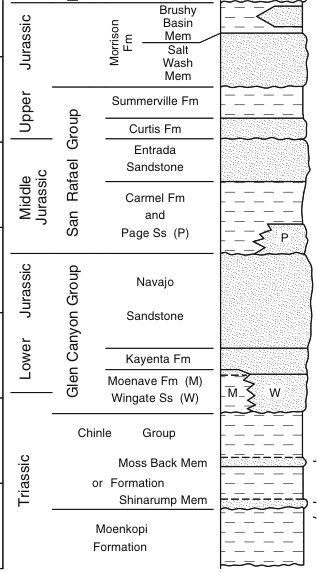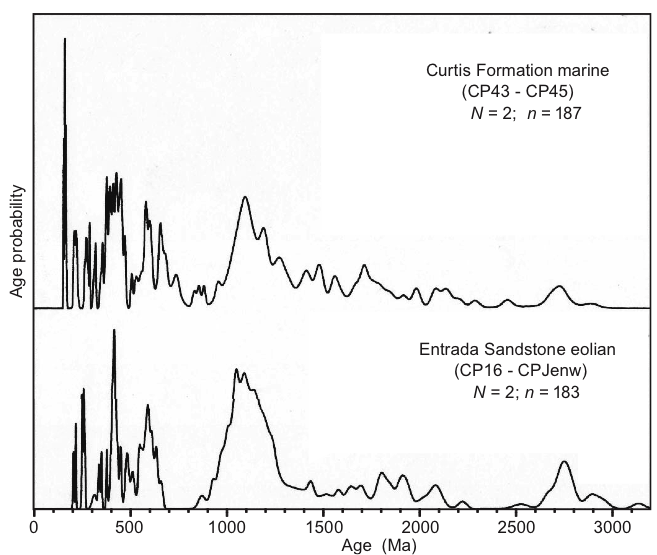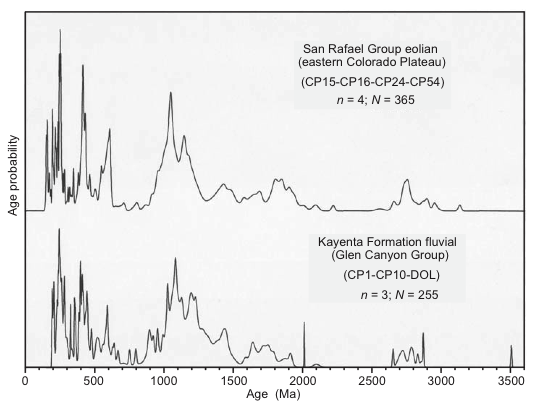 Fig 1. Idealized section showing stratigraphy used in this study. Taken from Dickinson and Gehrels (2009).
Fig 1. Idealized section showing stratigraphy used in this study. Taken from Dickinson and Gehrels (2009).Colin Sturrock
Mesozoic detrital zircons in Colorado Plateau sediments
 Fig 1. Idealized section showing stratigraphy used in this study. Taken from Dickinson and Gehrels (2009). Fig 1. Idealized section showing stratigraphy used in this study. Taken from Dickinson and Gehrels (2009). |
A central prediction of the alternative Cordilleran model presented in Hildebrand (2009, 2013) is that Triassic through early Cretaceous plutonism was absent from the western margin of North America and instead occurred on the micro-continent of Rubia. The western margin of North America would have been passive at this time until the docking of Rubia along a west dipping subduction zone at 124 Ma. The occurrence of late Triassic to early Cretaceous zircons in pre-124 Ma sediments well within North America would be difficult to explain within this framework, requiring a source that is not readily identifiable. This section examines late Permian to late Jurassic detrital zircons found in the middle to upper Jurassic Curtis and Entrada formations, the lower Jurassic Kayenta, and the upper Triassic Chinle formation.
Curtis and Entrada
The Entrada formation is a Jurassic eolian sandstone in the San Rafael Group overlain by the marine Curtis formation (Dickinson and Gehrels 2009). Paleowind directions in the Entrada are dominantly to the southeast (Dickinson and Gehrels 2009). Detrital zircon populations in the Entrada has statistically significant peaks as young as 200 Ma, with many in the age range 245 – 285 Ma (Dickinson and Gehrels 2009). The Curtis formation has statistical age peaks as young as 165 Ma, though most fall within the same range as the Entrada (Dickinson and Gehrels 2009). Statistical analysis shows that the Curtis formation is largely recycled from the Entrada. Possible sources for these zircon populations are the East Mexico Arc (284 – 232 Ma) (Torres et al. 1999), back arc magmatism in Nevada and western Utah (165 – 145 Ma) (Dickinson and Gehrels 2009), and mid-Triassic to mid-Jurassic Cordilleran arc magmatism (Dickinson 2004). There is some overlap between the latest zircon peaks in the Curtis and Entrada with the arc-derived Mt. Wrighton formation in southern Arizona (statistical peaks at 164 Ma, 178 Ma, and 219 Ma) (Dickinson and Gehrels 2009).
Kayenta
The fluvial sands that make up the Kayenta formation were transported dominantly west and northwest over the Wingate in the early Jurassic. Zircon populations in the Kayenta (statistical peaks 288-231 Ma) (Fig. 2) and paleocurrent indicators (NW) strongly imply an East Mexico Arc source (Dickinson and Gehrels 2009).
  |
Fig. 2 a & b.Probability density plots for Colorado Plateau units containing Permian-Jurassic zircons. Taken from (Dickinson and Gehrels 2009, 2010). |
Chinle
The upper Triassic Chinle Formation has been found to contain evidence of Cordilleran arc-derived zircons (Dickinson and Gehrels 2010; Riggs et al. 2016). Volcanic clasts within the basal Shinarump conglomerate yield ages from 232 – 224 Ma (Fig. 2) (Riggs et al. 2016), consistent with other Chinle detrital zircon work (220 – 245) (Fig. 2) (Dickinson and Gehrels 2010).
|
|
Fig. 2 (cont).Probability density plots for Chinle Formation containing Permian-Jurassic zircons. Taken from (Dickinson and Gehrels 2009, 2010) and (Riggs et al 2016). |
Tectonic implications
Taken within the commonly accepted framework for U.S. Cordilleran assembly, early Mesozoic zircons in Colorado Plateau confirm the existence of a volcanic arc in North America from the mid-Triassic to the mid-Jurassic (Dickinson 2004). Portions of these zircons are likely sourced from the East Mexico Arc, though the younger age groups (230-165) can only be explained as Cordilleran arc-sourced. It is unclear whether a sediment source in the East Mexico Arc would be inconsistent with the assertion of Hildebrand (2009) that arc magmatism was absent from the North American margin until the Eocene. Regardless, zircons <230 Ma in the fluvial, volcaniclastic, conglomeratic Shinarump member of the Chinle are especially difficult to explain in the absence of an early Mesozoic arc in western North America, as this clearly post-dates the East Mexico Arc and later arc magmatism in Mexico is thought to be a product of Cordilleran convergence (Torres et al. 1999; Dickinson and Lawton 2001). Collisional Cordilleran model (Hildebrand 2013) would need to initiate arc magmatism on North America much earlier than the preferred Eocene start.
References:
Dickinson, W. R. (2004). Evolution of the North American cordillera. Annu. Rev. Earth Planet. Sci., 32, 13-45.
Dickinson, W. R., & Lawton, T. F. (2001). Carboniferous to Cretaceous assembly and fragmentation of Mexico. Geological Society of America Bulletin, 113(9), 1142-1160.
Dickinson, W. R., & Gehrels, G. E. (2009). U-Pb ages of detrital zircons in Jurassic eolian and associated sandstones of the Colorado Plateau: Evidence for transcontinental dispersal and intraregional recycling of sediment. Geological Society of America Bulletin, 121(3-4), 408-433.
Dickinson, W. R., & Gehrels, G. E. (2010). Insights into North American paleogeography and paleotectonics from U–Pb ages of detrital zircons in Mesozoic strata of the Colorado Plateau, USA. International Journal of Earth Sciences, 99(6), 1247-1265.
Riggs, N. R., Oberling, Z. A., Howell, E. R., Parker, W. G., Barth, A. P., Cecil, M. R., & Martz, J. W. (2016). Sources of volcanic detritus in the basal Chinle Formation, southwestern Laurentia, and implications for the Early Mesozoic magmatic arc. Geosphere, GES01238-1.
Torres, R., Ruiz, J., Patchett, P. J., & Grajales, J. M. (1999). A Permo-Triassic continental arc in eastern Mexico: tectonic implications for reconstructions of southern North America. SPECIAL PAPERS-GEOLOGICAL SOCIETY OF AMERICA, 191-196.